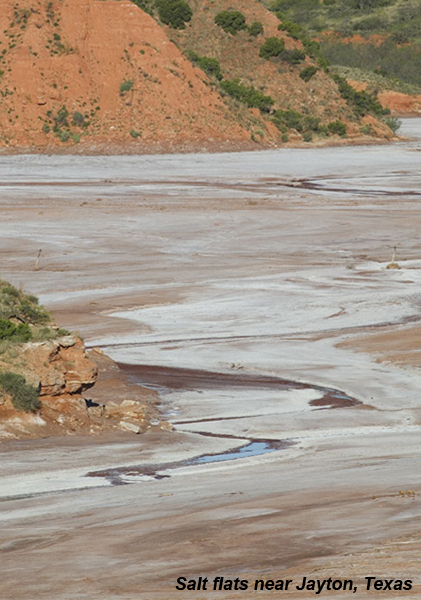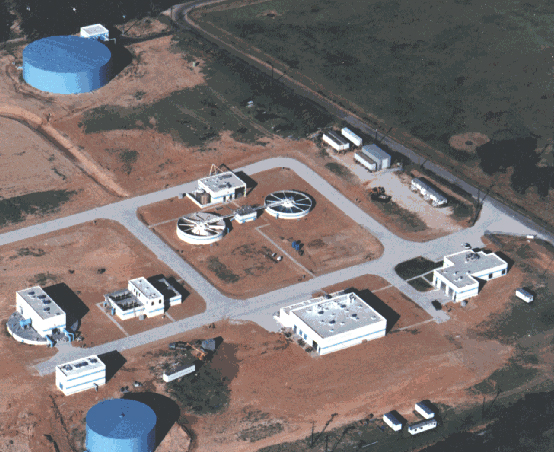
Legend holds that the Brazos was given its name by a group of Spanish explorers who were dying of thirst when they happened
upon the river. Thankful for the seemingly divine intervention that quenched their thirst, they dubbed the river Brazos de Dios, or “Arms of God.”
Not everyone has had such a positive first impression.
When U.S. Army Lt. Col. Samuel D. Sturgis encountered the river in 1876, he reported back to the War Department that the water
was so salty that even the mules would not drink it, writes Kenneth E. Hendrickson Jr. in his book, “The Waters of the Brazos.”
Throughout a six-county area southeast of Lubbock, a layer of white that covers much of the red dirt and mud looks like snow.
But this frost won’t melt even during the hot West Texas summers. It’s actually a layer of salt.
The geological phenomenon that gives the Salt Fork of the Brazos its name was formed millions of years ago when a shallow sea
that covered much of the region evaporated, leaving behind huge salt deposits. Underground, a vast aquifer of water with high chloride (or salts)
concentrations is another legacy of this bygone sea. Numerous seeps and springs in this area bring this water to the surface, where it evaporates
creating the salt flats.
The springs are the primary and constant source of salt loading in the Brazos, introducing up to 1000 tons of salt per day
directly into the Salt Fork of the Brazos and its tributaries. Compounding the problem are seasonal gully-washers or hard rains that sweep
through the region washing across the salt flats and adding yet more chlorides into the basin.
It is no surprise to those who live along the Brazos and use its waters that the river has salinity issues.
When used for irrigation, water with high concentrations of salt will kill most plants. In its natural state, it cannot be consumed
by humans and without extensive treatment is corrosive to household pipes, water heaters and appliances.

Downstream of the salt flats are reservoirs that supply drinking water to the upper region of the Brazos basin.
At times, chloride levels at Lakes Possum Kingdom and Granbury are higher than allowed under state drinking water standards. For example,
between 1997 and 2010, the average chloride concentration measured at Possum Kingdom Lake near the dam was 881 milligrams per liter (mg/L).
During the same period, the measurement near the Lake Granbury dam was 651 mg/L. While these readings are well below state standards for
surface water quality, they are higher than the Texas Commission on Environmental Quality’s drinking water standard of 300 mg/L. As a result,
before the water may be made available for human consumption, chloride levels must be lowered through water treatment.
Historically, Texans have examined many means of dealing with the natural salt issue including the construction of salt mining projects in some
areas of the state.
In 1989, in an effort to make the drinking water quality from Lake Granbury acceptable, the Brazos River Authority
established what was then somewhat of an oddity at Lake Granbury — a water desalinization plant far from the ocean.
The Lake Granbury Surface Water and Treatment System (SWATS), an inland desalination plant, treats water for the Cities of
Granbury and Keene, the Acton Municipal Utility District and the Johnson County Special Utilities District.
The SWATS plant uses a process called reverse osmosis to remove chlorides from the water, says Mike McClendon, the Authority’s
regional manager for the upper basin. High pressure forces the water molecules through a fine membrane that blocks contaminates such as chlorides.
Today, SWATS is not the only inland plant in the Brazos basin. At least two other desalinization plants are currently operating and three others are
planned.
Though the remaining untreated water at Lake Granbury may not be ideal for all uses, such as for some types of agriculture,
growers in the upper and central basin have adapted, focusing on pecan orchards and hearty varieties of grass for cattle.
While alternatives are being explored to address the salt issue on a larger scale, thus far they have proven too costly to
enact. That could change however as Texas’ population and the related demand for water continues to grow.
Removing salt at the point of use is not the only option that has been examined to address the issue. At least three other
possibilities have been studied over the last few decades to address the issue at its source, according to reports compiled by the Region G Water
Planning Group, the U.S. Army Corps of Engineers and the Texas Water Resources Institute at Texas A&M University.

One proposal calls for damming creeks in the Stonewall County area that contribute the highest amounts of chlorides in the basin.
When the salty water is washed by seasonal rains into these creeks, it would collect in reservoirs and would then be piped to a nearby larger reservoir
to evaporate.
A second idea would have wells dug into the aquifer to pull out salty water. This would lower the level in the aquifer,
preventing the water from seeping to the surface. The water pulled from the aquifer would then be piped to other areas, where it would return
underground into deep “injection” wells.
Officials have also considered a plan that would take water drawn from the aquifer and send it through a treatment process
similar to that used at the SWATS plant. The product would be usable water and salt available for sale to the public.
So far, none of these options has proven workable under current economic and demand conditions, says Tiffany Morgan,
Authority environmental and compliance manager.
Texas population is expected to more than double in the next 50 years. The increase in demand for water by this growing
number of thirsty Texans will require creative thinking to meet their needs. At that point, the cost of these options might seem more palatable.
Until then, the Authority will continue to help meet local demand by using its SWATS plant to remove salt from the
Brazos River’s drinking water.
